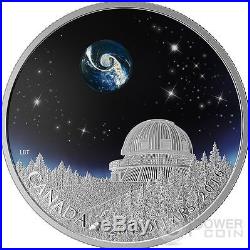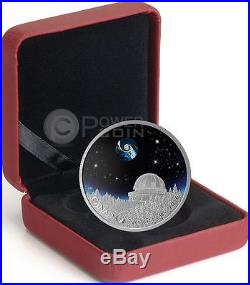




First coin featuring a combination of color and glow paint along with a specially selected borosilicate fine art coloured glass. Each glass piece is a unique piece of art, crafted with a swirl of silver dust to create an image of the universe that is one-of-a-kind. Added luminescence in the colored sky captures the faint glow of the galaxy a stunning effect that also shines from some of the stars. Canadian artist Loïc Beaumont-Tremblay has re-created the forested setting of the Mont-Mégantic Observatory beneath a clear, star-filled sky. A globule of borosilicate glass shines with a stunning image of the universe. The round, crystal-clear qualities of the glass are similar to peering through a telescope lens, and its luminescence further enhances the viewers experience of gazing into the galaxy. Universe The Universe is all of time and space and its contents. [8][9][10][11] The Universe includes planets, stars, galaxies, the contents of intergalactic space, the smallest subatomic particles, and all matter and energy. The observable universe is about 28 billion parsecs (91 billion light-years) in diameter at the present time. [2] The size of the whole Universe is not known and may be infinite. Observations and the development of physical theories have led to inferences about the composition and evolution of the Universe. Throughout recorded history, cosmologies and cosmogonies, including scientific models, have been proposed to explain observations of the Universe. The earliest quantitative geocentric models were developed by ancient Greek philosophers and Indian philosophers. Over the centuries, more precise astronomical observations led to Nicolaus Copernicus’s heliocentric model of the Solar System and Johannes Kepler’s improvement on that model with elliptical orbits, which was eventually explained by Isaac Newton’s theory of gravity. Further observational improvements led to the realization that the Solar System is located in a galaxy composed of billions of stars, the Milky Way. It was subsequently discovered that our galaxy is just one of many. Observations of the distribution of these galaxies and their spectral lines have led to many of the theories of modern physical cosmology. The discovery in the early 20th century that galaxies are systematically redshifted suggested that the Universe is expanding, and the discovery of the cosmic microwave background radiation suggested that the Universe had a beginning. Finally, observations in the late 1990s indicated the rate of the expansion of the Universe is increasing[16] indicating that the majority of energy is most likely in an unknown form called dark energy. The majority of mass in the universe also appears to exist in an unknown form, called dark matter. The Big Bang theory is the prevailing cosmological model describing the development of the Universe. Space and time were created in the Big Bang, and these were imbued with a fixed amount of energy and matter; as space expands, the density of that matter and energy decreases. After the initial expansion, the Universe cooled sufficiently to allow the formation first of subatomic particles and later of simple atoms. Giant clouds of these primordial elements later coalesced through gravity to form stars. Assuming that the prevailing model is correct, the age of the Universe is measured to be 13.798±0.037 billion years. There are many competing hypotheses about the ultimate fate of the Universe. Physicists and philosophers remain unsure about what, if anything, preceded the Big Bang. Many refuse to speculate, doubting that any information from any such prior state could ever be accessible. There are various multiverse hypotheses, in which some physicists have suggested that the Universe might be one among many universes that likewise exist. The item “THE UNIVERSE Borosilicate Glass Glow In The Dark Silver Coin 20$ Canada 2016″ is in sale since Monday, August 31, 2015. This item is in the category “Coins & Paper Money\Coins\ Canada\Commemorative”. The seller is “powercoin_italy” and is located in Roma. This item can be shipped worldwide.
- Circulated/Uncirculated: Uncirculated
- Country/Region of Manufacture: Canada
